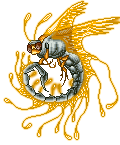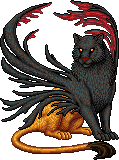Hey all-With Morg's permission, I decided to make a small thread that will address some of the issues that continuously crop up in people’s writing. This is a quick reference guide, so it won’t be perfect, but I figured the Tea House could use one. Some of these tips are guidelines to help make your writing more readable and to brush up on the basics, while others are more advanced craft techniques that can spice up a story.
I’ll be using the first part of my story as an example, to help explain what I mean in some cases. So, let’s just get right to it.
***********
The Basics:
Dialogue:
Remember, a new paragraph starts with every new speaker. If you don’t start a new paragraph with every speaker, you end up with a wall of text that will send most readers to the hills, like this:
Spoiler
Spoiler
Rayen ran a hand through his red hair, mussing it up in his nervousness as he stood up from his place at the mahogany desk. “It...just kind of called to me.” He cursed the words for sounding stupid even as he spoke them, despite their veracity.
“Hmm. So it was the only one?” Nathan's mouth turned up in an unkind smirk. “You only saw the one?”
“I saw others!” Rayen protested. “They just...weren't as clear.”
However, it still looks rather clumped and messy. That brings me to another basic point.
Paragraph spacing:
When you start a new paragraph, insert an empty space. This makes electronic writing much, much easier to read, since reading clumped writing on a bright screen can be taxing for many people. With spacing between paragraphs, your writing will look much cleaner, like so:
Spoiler
Rayen ran a hand through his red hair, mussing it up in his nervousness as he stood up from his place at the mahogany desk. “It...just kind of called to me.” He cursed the words for sounding stupid even as he spoke them, despite their veracity.
“Hmm. So it was the only one?” Nathan's mouth turned up in an unkind smirk. “You only saw the one?”
“I saw others!” Rayen protested. “They just...weren't as clear.”
Finally, and I feel the need to bring these up even though I’m sure most people already know them, the bitty basics once you have your formatting in order.
-Capitalize the first word of a sentence. “I” is capitalized. Names of people and places are generally capitalized.
-Dialogue should be in quotation marks, with the following word in lower case if you are indicating the speaker. For example: “I’m Bob,” he said.
The following word need not be in lowercase if you are not indicating the speaker (as in, not using he/she said). For example: The man stood up. “I’m Bob.” Everyone was amazed by his awesome name.
-Run on sentences are not your friend. If your sentence goes on and on for longer than three lines, it can probably be safely divided into two. (Run on sentences are alright in dialogue, however, if that’s how your character speaks).
-Vary your sentence structure. Don't make every sentence in your story the same length, and avoid primarily using extremely short, non-descriptive sentences. This will liven up your story.
-Misplaced modifiers are incorrect and sometimes embarrasing-“the torn student’s book lay on the desk.” The adjective should be near the word it is describing, so a fix for that sentence would be “the student’s torn book lay on the desk.”
Another form is with adverbs-“The magi rode the fat pegasus he had brought slowly.” Is he riding slowly or did he bring the pegasus slowly?
The last thing I’ll say for the basics is proofread, proofread, proofread. A few typos are easy to miss, but if you have sentences that don’t make sense, spelling errors galore, and your work is full of typos, it doesn’t look good. People aren’t going to waste their time reading something that you obviously didn’t put any effort into.
Luckily, formatting your story with the guidelines above will make proofreading easier.
More Advanced Storytelling Techniques
There are a few errors that many new writers make often. I’ll start with the one that plagued my writing early on.
Passive Writing:
Passive writing is when the subject of the sentence is what is being acted upon. For example, “The orb was dropped by the magi.” The orb is being acted upon-the magi is dropping it-but it’s the subject of our sentence. The active version of the sentence would be “The magi dropped the orb.”
Passive writing is not grammatically incorrect-both are perfectly fine sentences. But when used to an extreme, it can make a story very boring.
“The orb was dropped by the magi, and the floor was covered in glass.” This sounds rather boring. “The magi dropped the orb, glass covering the floor.” This sounds much more active and exciting.
Active voice also keeps writing clear-we could easily have written “the orb was dropped,” above and left it at that. But because it’s a passive sentence, we don’t know who dropped the orb. The magi? His creature? Belmos? Passive writing can too easily turn into lazy writing.
With that said, sometimes passive writing can be used effectively, and it is not always a mistake to use it. However, if you find yourself using the word “was” too often, you should look into your writing and see if passivity is a problem.
Many writers rely on passive voice too often to describe things. “The mountain was big, and the trees around it were very green. The dirt underneath the trees was red. This was unusual.” This is not a very effective way to describe anything. A better way to describe it would be “Deep green trees dotted the enormous mountain, the setting sun bathing the dirt in an unusual red hue.” This is more active, and sets the scene in a more interesting way.
In sum, watch out for passive voice. It has a place, but that place is not your entire story.
Show, don’t Tell:
The other major problem writers run into is one that every single writing workshop (apparently) advises about-show, don’t tell. Unfortunately, not many workshops actually explain what the heck they mean.
Telling a story is just that-telling the reader everything and not letting them think for themselves or make any implications.
“Rayen was very nervous about the magical creature duel with Nathan.” This is telling. The reader now knows that Rayen is nervous, and that there is mage duel, but they have not been entertained in any way.
“Rayen’s heart pounded. Nathan smirked at him from across the dusty dueling ring, the Enox at his heels baring its fangs.” This is showing-the reader can infer that Rayen is nervous from his heart pounding, and they can infer that there is a duel using creatures from the language used.
As you can see above, showing sometimes requires more words than telling does. This is fine-you want your story to entertain, not bore! Telling is the quick, easy way out, spoonfeeding your story as though your audience is a bunch of morons. They aren’t. Most readers are perfectly capable of making the inferences required.
Some forms of telling are very easy to spot-Phrases like “He looked,” “He watched,” or “He heard,” are often unnecessary. Don’t tell us he heard it, show us what the noise was. Don’t tell us he watched the dance, describe the dance. Your readers will infer that your MC is watching it.
Another form that’s easy to spot is repetitive sentence structure. If every single one of your sentences in a paragraph has the basic form “He verbed,” you are probably telling when you should be showing.
The main idea behind showing and not telling is to leave things open for your reader’s imaginations-keep it active, and keep it interesting. Some amount of telling is necessary, but like passive voice, don’t overdo it.
Infodumps:
An infodump is when the author (or a character) decides to suddenly describe something to the audience about their world or a character all at once. Sometimes it comes at the very beginning of a story, where the author feels the need to describe how the setting works as though it’s the beginning of a roleplay, or sometimes it comes when the author decides to describe a character and all their traits, as though it’s a roleplay. Don’t do this. A fiction story is not a roleplay.
Rather than rely on infodumps, sprinkle information about the world throughout your story-readers like discovering new worlds as they read, not having it all flung at them. For characterization, show the readers your character through that character’s actions. Don’t just give them a list of traits and expect your readers to simply believe them-If I wrote something like “Nathan was a very timid man” and all he did the rest of the story was pick fights, then there’s something wrong, on top of the fact that describing your character that way is boring.
If you have an entire paragraph whose only purpose is to explain how something works, strongly consider mixing it into other paragraphs and doling out information in a more controlled way. Infodumps are boring, interrupt the flow of a story, and turn readers off
Chacterization:
The last thing I will discuss is characterization, which can make or break a story.
I touched upon it above, but do not present your characters as though they are RP characters. The reader should be allowed to discover your character as the story goes on, and hopefully, watch the character change over time. If you write a long list of traits at the beginning, you are limiting your character’s chances to grow throughout the story.
Keep characters consistent. If they change, make it believable-don’t have a character who is ordinarily timid suddenly become super aggressive unless you have a very good reason.
Show growth-Keep consistency in mind, but by the end of the story the character should be affected at least marginally by what has happened to them throughout the story. If they aren’t, you should consider if your plot is truly as interesting as you thought it was.
Keep readers in mind-Don’t decide your character is a certain way and then present them without expecting alternative views. A lot of writers run into this trap. They outline every single facet of their character’s personality, and then write their story intending the character to be perceived a certain way. However, since the readers don’t know all of the background, they perceive the character completely differently. It doesn’t matter if you secretly know that Character X has a tragic past that made him into a murderer-if the readers don’t have any hint of that past, they’re going to think that Character X is just a dick.
When writing, it is advisable to pick a certain POV and stick with it. If you’re choosing third person limited, stay with the character you’ve chosen-don’t head hop. If I’m writing through Rayen’s POV, I shouldn’t suddenly start writing what Nathan is experiencing.
Make characters unique-characters should have distinct voices and personalities. If everyone speaks in the same style and acts in the same way, you are not delineating your characters well enough, and this can ruin conflict. If one character is timid and the other is aggressive, show it through their actions and speaking style-have the aggressive character talk more and talk over the timid one, for example.
And finally, for the love of God, avoid Mary Sues if you can. Every character has flaws. Don’t make a character with ridiculous appearances or powers unless they fit the world they’re in (Like the DC universe
***********
These are just a few tips to help people write clearer, more effective stories. They don’t encompass every facet of good writing, but they do address some of the problems I’ve seen around the Tea House, and hopefully they will help some people in their writing endeavors.
Of course, if you see something you think is incorrect, want something expanded on further, or just want to tell me I’m a huge moron, feel free to PM me. I’m just one person, after all, and writing is subjective.



 [/url[url=http://magistream.com/creature/6939156]
[/url[url=http://magistream.com/creature/6939156]
 [/url]
[/url]
 [/url[url=http://magistream.com/creature/6947383]
[/url[url=http://magistream.com/creature/6947383]

















































